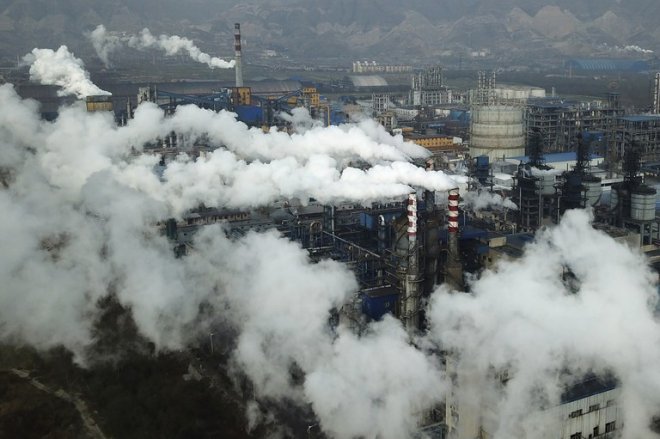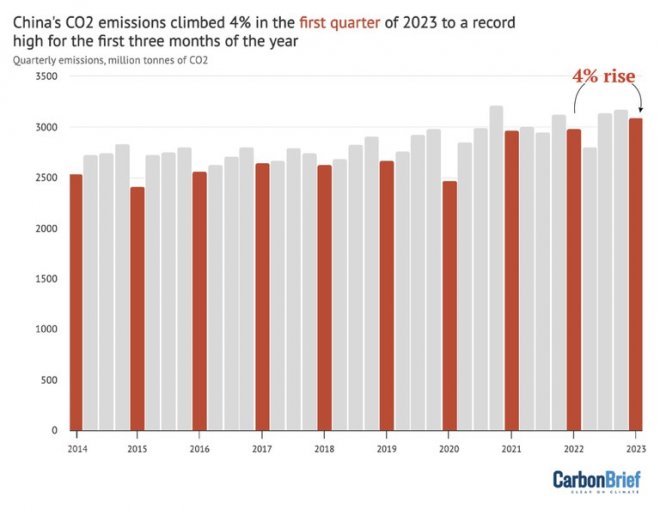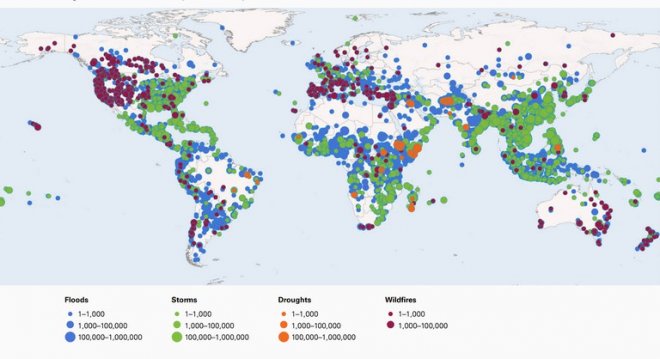China’s CO2 emissions hit record in first quarter, report says
China, the world’s top polluter, has emitted record carbon dioxide in the first quarter of this year, with emissions set to rise to an all-time high in 2023, according to a new report published on Friday.CO2 emissions grew by 4% in the first three months of 2023 compared to last year, to hit a quarterly record high of more than 3 billion metric tons, according to an analysis by the Centre for Research on Energy and Clean Air (CREA), a Finland-based independent organization.
The analysis is based on official figures and commercial data and was first published on the Carbon Brief news website.
The authors of the report said the increase was driven by a robust economic rebound after the end of China’s extended and much-criticized zero-COVID policy, stimulus measures in manufacturing and construction sectors, and weak hydropower generation due to low rainfall and ongoing drought.
“Looking at the rest of the year, the government’s focus on economic growth means that China’s emissions are likely to reach an all-time high in 2023, topping the previous peak in 2021,” CREA analysts Lauri Myllyvirta and Qi Qin said in the report.
Typically, the first quarter has the lowest emissions since things slow down during the annual Lunar New Year celebrations.
The most significant contributors to the growth in emissions were coal-powered electricity generation and higher production of construction materials, mainly steel and cement.
The increase in heavy industry production and emissions has raised worries about reversing recent air quality progress, particularly in Beijing, as the government last year broke its streak since 2017 of issuing air pollution action plans that limit heavy industry from spewing bad air.
Question of priorities
That has been interpreted to signify that industrial growth is prioritized over air quality.
Approvals for new coal power capacity, which increased sharply in the second half of last year, continued to rise this year, with at least 10 gigawatts (GW) of coal power projects approved in the first quarter of 2023.
 Smoke and steam rise from a coal processing plant in Hejin, Shanxi Province, China, Nov. 28, 2019. Credit: AP.
Smoke and steam rise from a coal processing plant in Hejin, Shanxi Province, China, Nov. 28, 2019. Credit: AP.Contrary to widespread perception, China’s new wave of coal power plants will not automatically translate into an increase in its coal use or CO2 emissions, the authors said.
“The combination of rapid expansion of low-carbon energy supplies and expected slower electricity demand growth means China’s annual coal power output could soon start to decline,” the duo said.
Additions of renewable energy, specifically wind and solar, have also reached record highs in the same period, passing “50% of China’s installed power capacity for the first time, overtaking coal and other fossil fuel-based capacity,” according to the report.
China beat its 2022 target by 5GW of new solar and wind capacity, installing 125GW by the end of the year. It plans to reach 160 GW this year.
Beijing is also speeding up nuclear power projects, on track to have 70GW in operation and 30GW under construction by 2025.
CREA said a continued rapid expansion of low-carbon energy, if sustained, could enable emissions to peak and enter structural decline, once the post-COVID recovery has played out.
Zero emissions by 2060
China officially plans to reach its peak emissions by 2030 and then gradually reduce them to try to achieve net zero carbon emissions by 2060.
In a report last month, another global energy think tank, Ember, said China created the most CO2 emissions of any power producer globally in 2022, with 4,694 million metric tons of CO2, accounting for 38% of total global emissions from electricity generation.
 China’s quarterly CO2 emissions from fossil fuels and cement, million tonnes of CO2. Credit: Carbon Brief.
China’s quarterly CO2 emissions from fossil fuels and cement, million tonnes of CO2. Credit: Carbon Brief.According to CREA, the new wave of coal power plants is not driven by increasing annual electricity demand. “The real driver is concern about meeting peak demand,” it said on Friday.
Since the power shortages in 2021, followed by last year’s record heatwave, energy security concerns have haunted Beijing, forcing them to increase reliance on coal.
Last year, Beijing approved the highest new coal capacity in eight years.
Environment group Greenpeace said last month that China approved at least 20.45 GW of new coal in the first three months of 2023, according to official approval documents.
In 2020, it approved at least 90.72GW of new coal power, the group said, with energy security concerns cited as the reason for most.
Edited by Malcolm Foster
[圖擷取自網路,如有疑問請私訊]
|
本篇 |
不想錯過? 請追蹤FB專頁! |
| 喜歡這篇嗎?快分享吧! |
相關文章
AsianNewsCast























